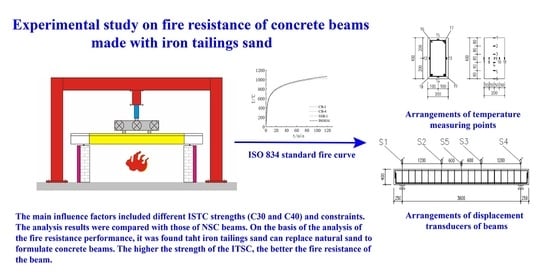Experimental Study on Fire Resistance of Concrete Beams Made with Iron Tailings Sand
Abstract
1. Introduction
2. Experiment Design
2.1. Specimen Design
2.2. Loading Scheme and Heating System
2.3. Measuring Point Arrangement
3. Experiment Result
3.1. Experimental Phenomenon
3.2. Fracture Distribution and Failure Characteristics
3.3. Temperature of Concrete and Reinforcement in the Beam
3.4. Deformation after Being Subject to Fire
3.5. Fire Endurance and Residual Bearing Capacity
4. Discussion
5. Conclusions
Author Contributions
Funding
Institutional Review Board Statement
Informed Consent Statement
Data Availability Statement
Conflicts of Interest
References
- Mathews, M.E.; Andrushia, A.D.; Kiran, T.; Yadav, B.S.K.; Kanagaraj, B.; Anand, N. Structural response of self-compacting concrete beams under elevated temperature. Mater. Today Proc. 2022, 49, 1246–1254. [Google Scholar] [CrossRef]
- Khaliq, W.; Khan, H.A. High temperature material properties of calcium aluminate cement concrete. Constr. Build. Mater. 2015, 94, 475–487. [Google Scholar] [CrossRef]
- Ryu, E.; Shin, Y.; Kim, H. Effect of Loading and Beam Sizes on the Structural Behaviors of Reinforced Concrete Beams Under and After Fire. Int. J. Concr. Struct. Mater. 2018, 12, 54. [Google Scholar] [CrossRef]
- Choi, E.G.; Shin, Y.-S.; Kim, H.S. Structural damage evaluation of reinforced concrete beams exposed to high temperatures. J. Fire Prot. Eng. 2013, 23, 135–151. [Google Scholar] [CrossRef]
- Phan, L.T. Pore pressure and explosive spalling in concrete. Mater. Struct. 2008, 41, 1623–1632. [Google Scholar] [CrossRef]
- Hassan, A.; Khairallah, F.; Elsayed, H.; Salman, A.; Mamdouh, H. Behaviour of concrete beams reinforced using basalt and steel bars under fire exposure. Eng. Struct. 2021, 238, 112251. [Google Scholar] [CrossRef]
- Le, Q.X.; Torero, J.; Dao, V.T. Stress–strain–temperature relationship for concrete. Fire Saf. J. 2020, 120, 103126. [Google Scholar] [CrossRef]
- Ma, W. Behavior of Aged Reinforced Concrete Columns under High Sustained Concentric and Eccentric Loads, Order No. 28542353 ed.; University of Nevada: Las Vegas, NV, USA, 2021. [Google Scholar]
- Dwaikat, M.B.; Kodur, V.K.R. Response of Restrained Concrete Beams under Design Fire Exposure. J. Struct. Eng. 2009, 135, 1408–1417. [Google Scholar] [CrossRef]
- Choi, E.; Shin, Y. The structural behavior and simplified thermal analysis of normal-strength and high-strength concrete beams under fire. Eng. Struct. 2011, 33, 1123–1132. [Google Scholar] [CrossRef]
- Gao, W.; Dai, J.-G.; Teng, J.; Chen, G. Finite element modeling of reinforced concrete beams exposed to fire. Eng. Struct. 2013, 52, 488–501. [Google Scholar] [CrossRef]
- Ožbolt, J.; Bošnjak, J.; Periškić, G.; Sharma, A. 3D numerical analysis of reinforced concrete beams exposed to elevated temperature. Eng. Struct. 2014, 58, 166–174. [Google Scholar] [CrossRef]
- Zuccheratte, A.C.V.; Freire, C.; Lameiras, F.S. Synthetic gravel for concrete obtained from sandy iron ore tailing and recycled polyethyltherephtalate. Constr. Build. Mater. 2017, 151, 859–865. [Google Scholar] [CrossRef]
- Prakash, A.; Swaminathen, A.; Ramu, A.; Chaitanya, B.K. Assessment of strength and durability parameters for concrete with partial replacement of coarse aggregates by iron slag and glass powder as an additive. IOP Conf. Series Mater. Sci. Eng. 2021, 1126, 012082. [Google Scholar] [CrossRef]
- Karthikeyan, B.; Kathyayini, R.; Kumar, V.A.; Uthra, V.; Kumaran, S.S. Effect of dumped iron ore tailing waste as fine aggregate with steel and basalt fibre in improving the performance of concrete. Mater. Today Proc. 2021, 46, 7624–7632. [Google Scholar] [CrossRef]
- Upadhyay, R.; Venkatesh, A.S. Current strategies and future challenges on exploration, beneficiation and value addition of iron ore resources with special emphasis on iron ores from Eastern India. Appl. Earth Sci. 2006, 115, 187–195. [Google Scholar] [CrossRef]
- Prabhu, G.G.; Hyun, J.H.; Kim, Y.Y. Effects of foundry sand as a fine aggregate in concrete production. Constr. Build. Mater. 2014, 70, 514–521. [Google Scholar] [CrossRef]
- Ismail, Z.Z.; Al-Hashmi, E.A. Reuse of waste iron as a partial replacement of sand in concrete. Waste Manag. 2008, 28, 2048–2053. [Google Scholar] [CrossRef]
- Ahmed, T.; Elchalakani, M.; Basarir, H.; Karrech, A.; Sadrossadat, E.; Yang, B. Development of ECO-UHPC utilizing gold mine tailings as quartz sand alternative. Clean. Eng. Technol. 2021, 4, 100176. [Google Scholar] [CrossRef]
- Shettima, A.U.; Hussin, M.W.; Ahmad, Y.; Mirza, J. Evaluation of iron ore tailings as replacement for fine aggregate in concrete. Constr. Build. Mater. 2016, 120, 72–79. [Google Scholar] [CrossRef]
- Oritola, S.F.; Saleh, A.L.; Sam, A.R.M. Characterization of Iron Ore Tailings as Fine Aggregate. ACI Mater. J. 2020, 117, 125–134. [Google Scholar] [CrossRef]
- Miraldo, S.; Lopes, S.; Pacheco-Torgal, F.; Lopes, A. Advantages and shortcomings of the utilization of recycled wastes as aggregates in structural concretes. Constr. Build. Mater. 2021, 298, 123729. [Google Scholar] [CrossRef]
- Kranti, J.U.; Sai, A.N.; Krishna, A.R.; Srinivasu, K. An experimental investigation on effect of durability on strength properties of M40 grade concrete with partial replacement of sand with copper slag. Mater. Today Proc. 2020, 43, 1626–1633. [Google Scholar] [CrossRef]
- Jayasimha, N.; Sujini, B.; Annapurna, B. A study on durability and strength properties of high strength concrete with partial replacement of iron ore tailings with fine aggregates. Mater. Today Proc. 2022, 62, 1922–1929. [Google Scholar] [CrossRef]
- Bezerra, C.G.; Rocha, C.A.A.; de Siqueira, I.S.; Filho, R.D.T. Feasibility of iron-rich ore tailing as supplementary cementitious material in cement pastes. Constr. Build. Mater. 2021, 303, 124496. [Google Scholar] [CrossRef]
- Duan, P.; Yan, C.; Zhou, W.; Ren, D. Fresh properties, compressive strength and microstructure of fly ash geopolymer paste blended with iron ore tailing under thermal cycle. Constr. Build. Mater. 2016, 118, 76–88. [Google Scholar] [CrossRef]
- Zhu, Q.; Yuan, Y.-X.; Chen, J.-H.; Fan, L.; Yang, H. Research on the high-temperature resistance of recycled aggregate concrete with iron tailing sand. Constr. Build. Mater. 2022, 327, 126889. [Google Scholar] [CrossRef]
- Hou, Y.F. Comparison of Effect of Iron Tailing Sand and Natural Sand on Concrete Properties. Key Eng. Mater. 2014, 599, 11–14. [Google Scholar] [CrossRef]
- British Standards Institution. Design of Composite Steel and Concrete Structures: Eurocode 4; British Standards Institution: London, UK, 2006. [Google Scholar]
- ISO 834-10; Fire-Resistance Tests-Elements of Building Construction-Part 10: Performance Criteria. ISO: Geneva, Switzerland, 1999.
- Huang, Z.; Padmaja, K.; Li, S.; Richard Liew, J.R. Mechanical properties and microstructure of ultra-lightweight cement composites with fly ash cenospheres after exposure to high temperatures. Constr. Build. Mater. 2018, 164, 760–774. [Google Scholar] [CrossRef]
- Zhang, B. Effects of moisture evaporation (weight loss) on fracture properties of high performance concrete subjected to high temperatures. Fire Saf. J. 2011, 46, 543–549. [Google Scholar] [CrossRef]
- Pan, Z.; Zheng, W.; Xiao, J.; Chen, Z.; Chen, Y.; Xu, J. Shear behavior of steel reinforced recycled aggregate concrete beams after exposure to elevated temperatures. J. Build. Eng. 2021, 48, 103953. [Google Scholar] [CrossRef]
- Yu, J.; Liu, Y.; Lu, Z.; Xiang, K. Experimental Study on damage and rehabilitation of reinforced concrete continuous member after fire. J. Tongji Univ. (Nat. Sci.) 2012, 40, 508–514. [Google Scholar] [CrossRef]

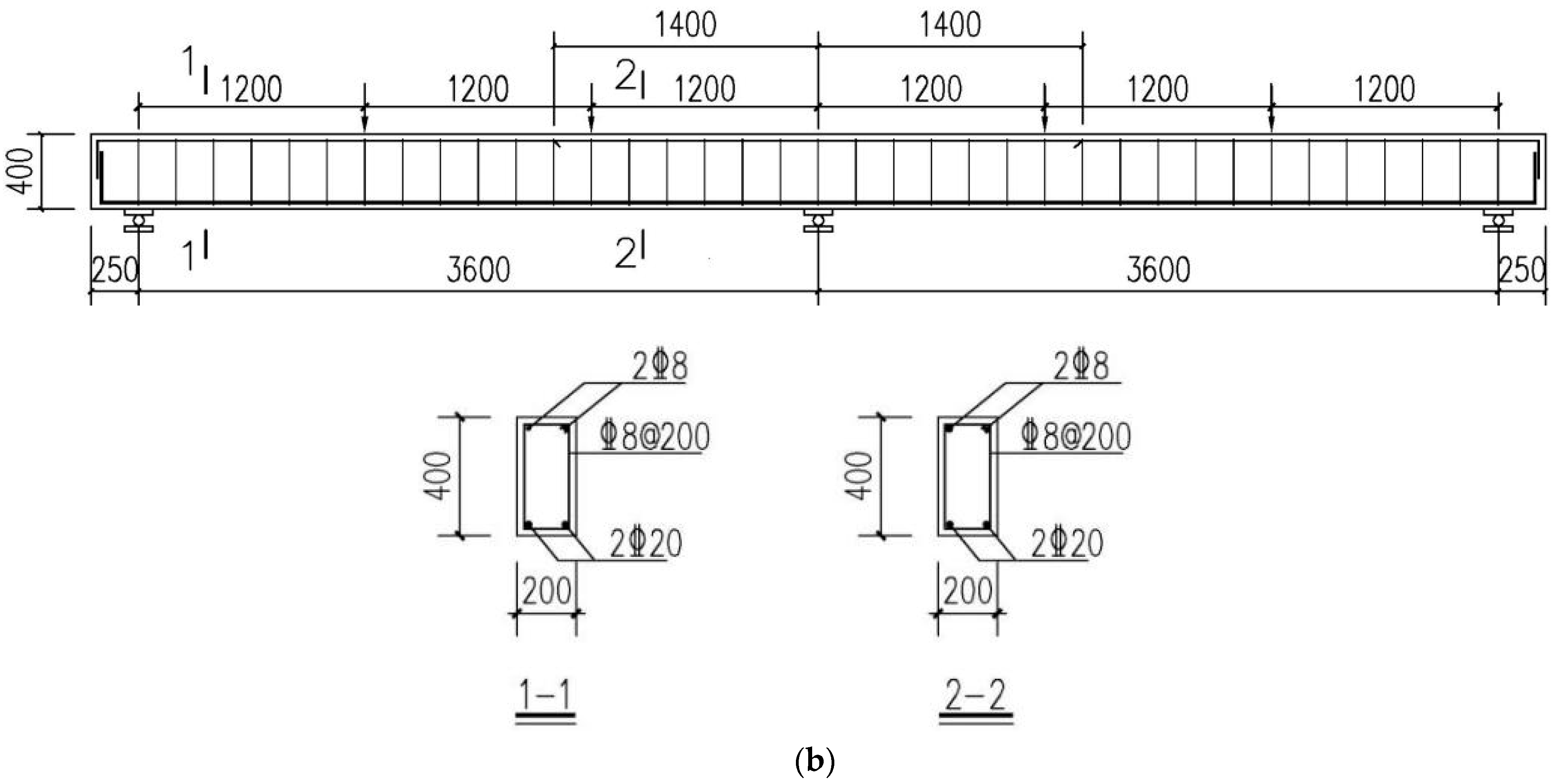

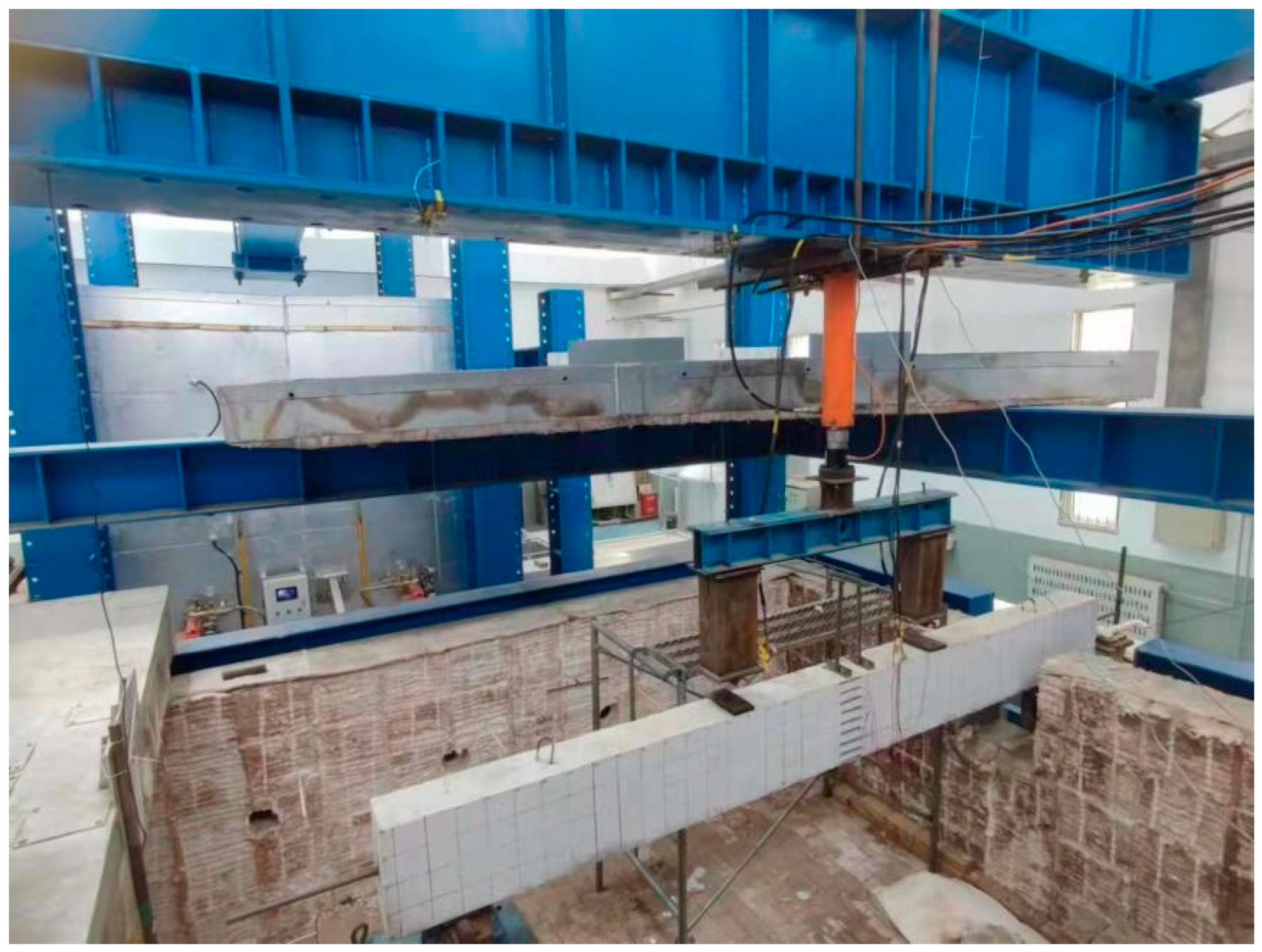
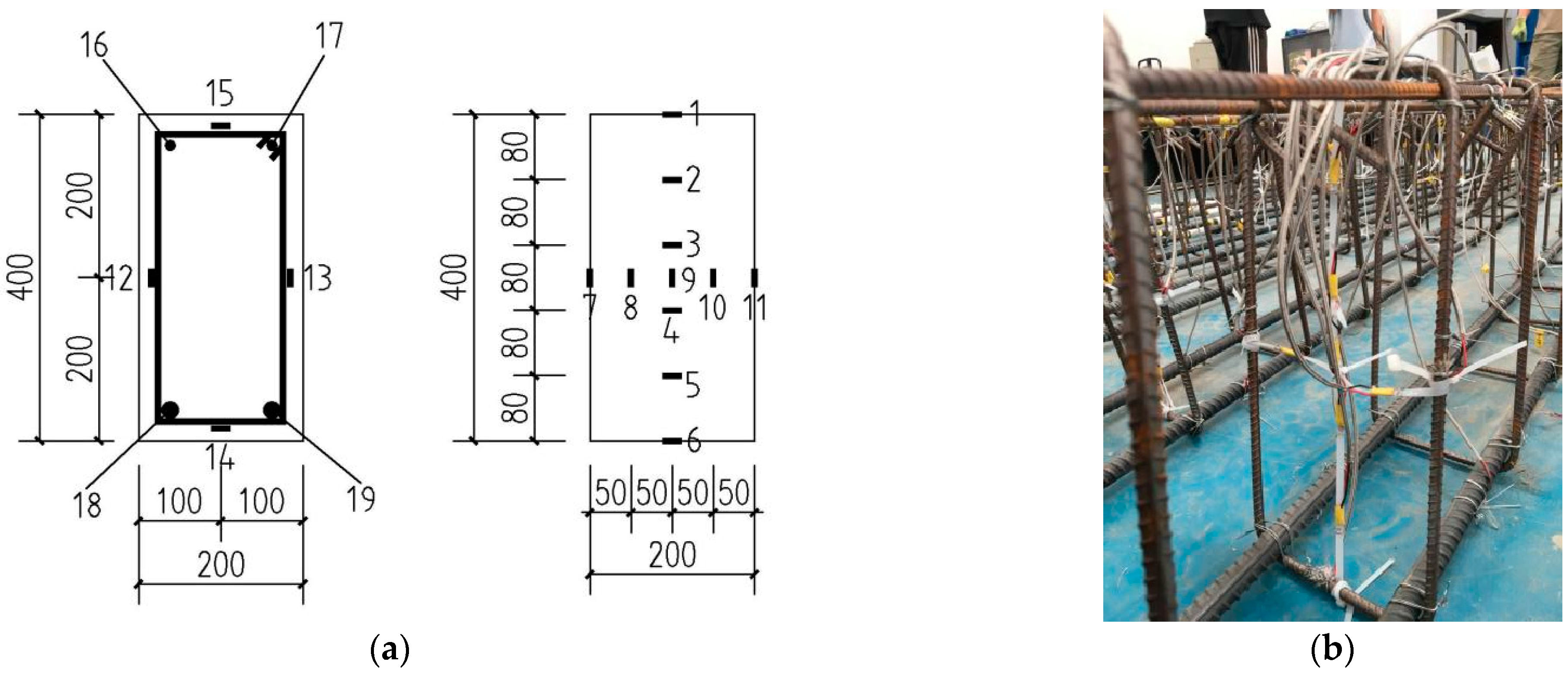
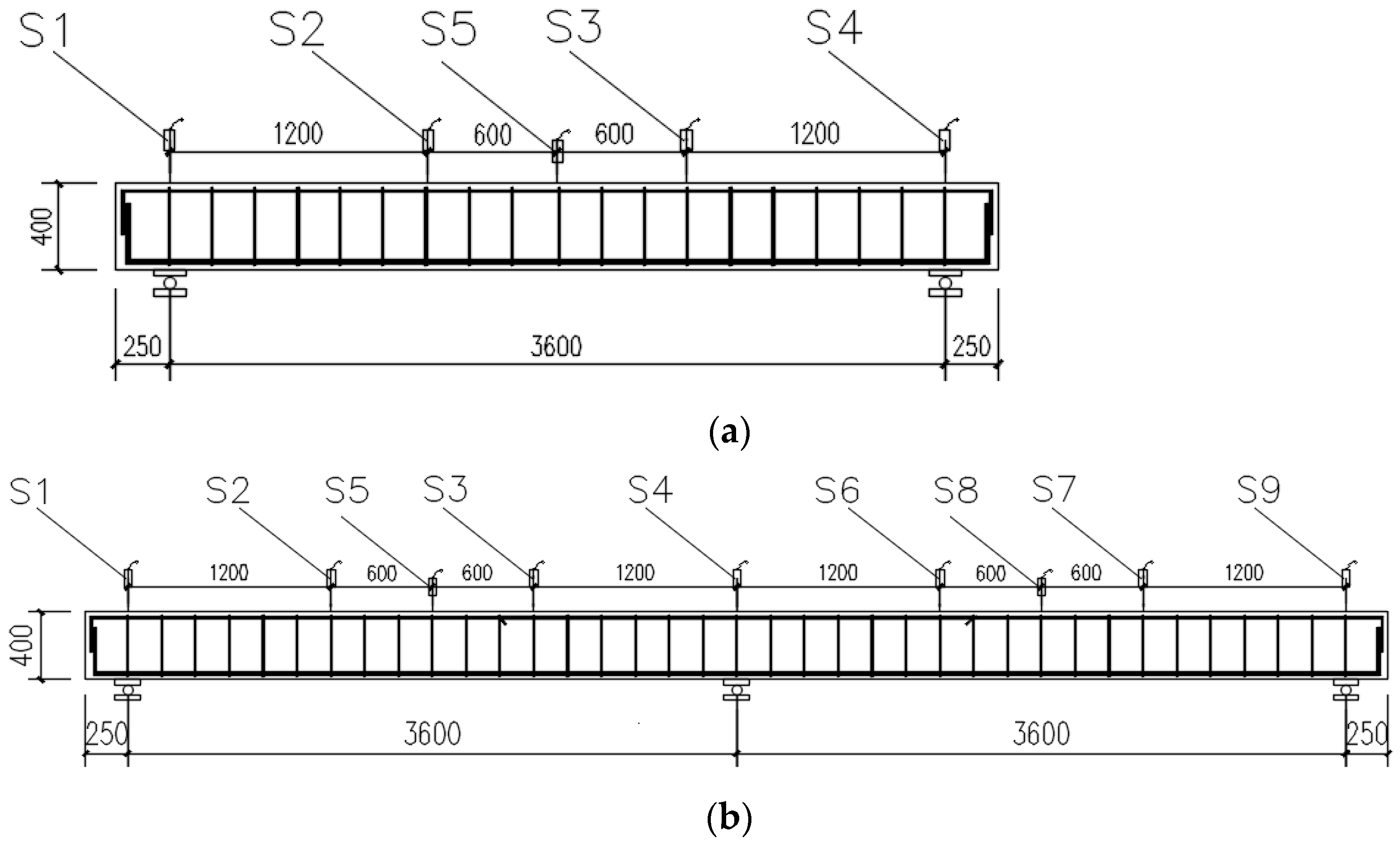
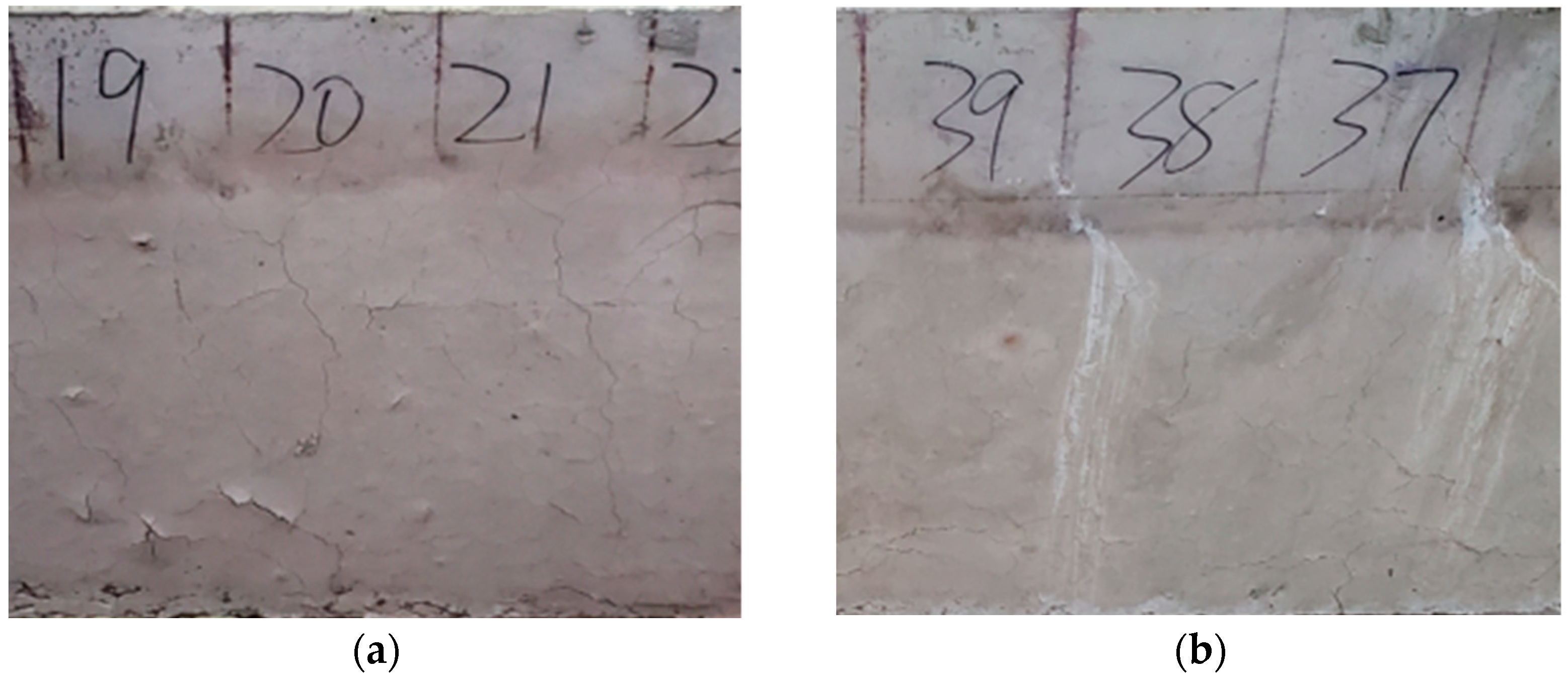
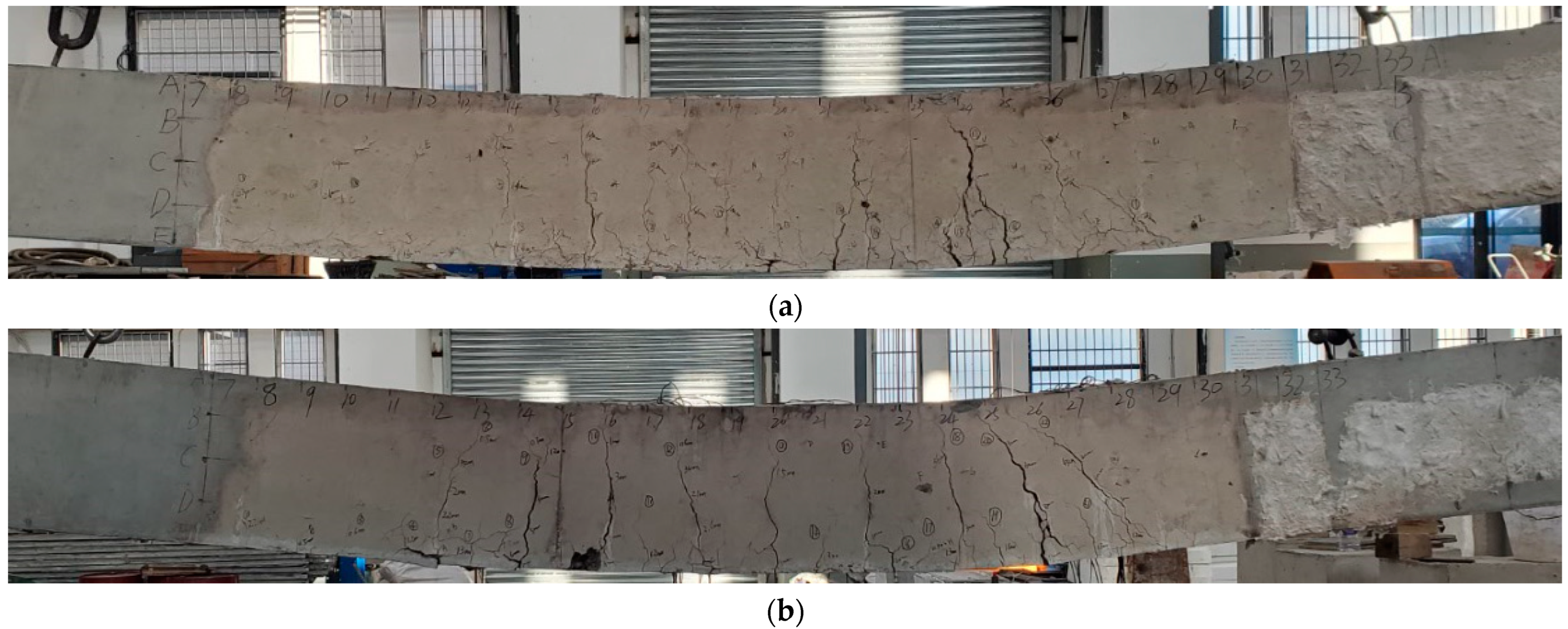

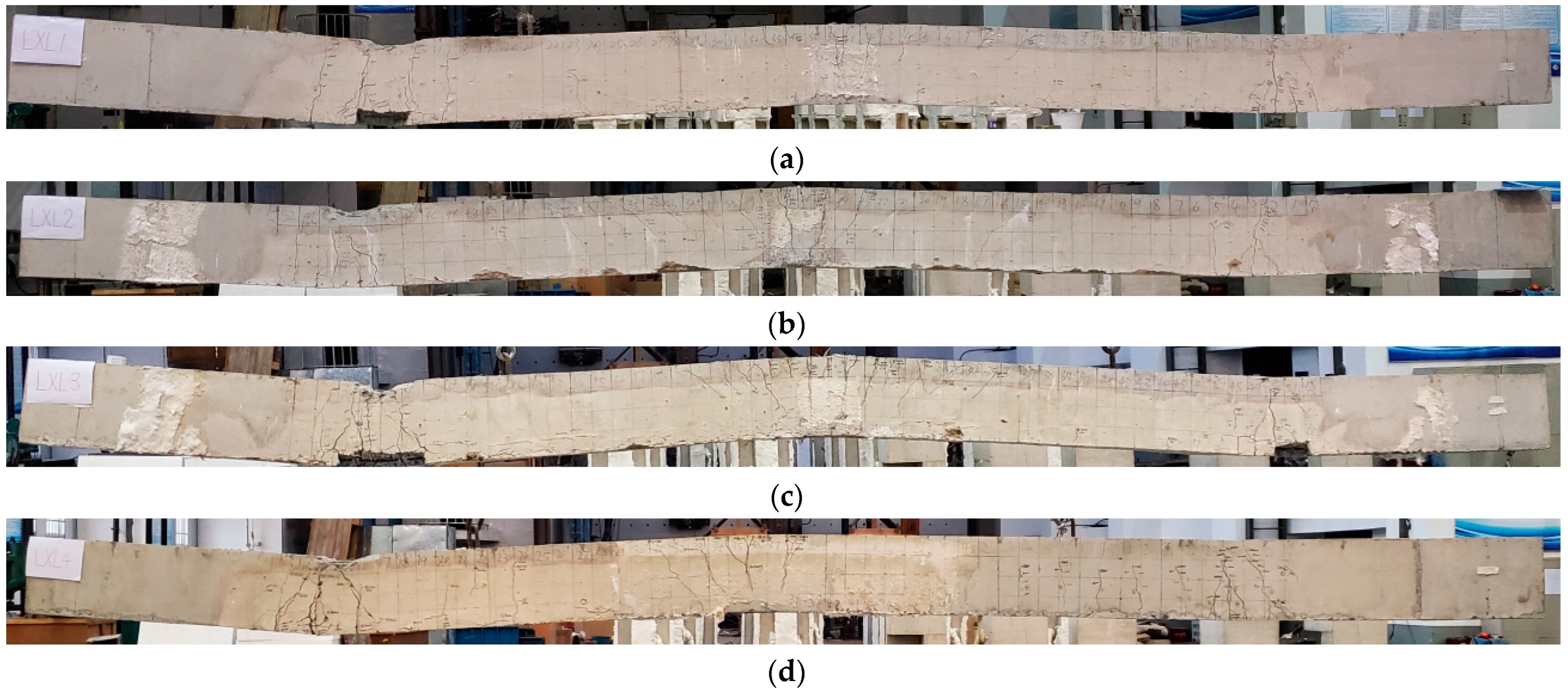
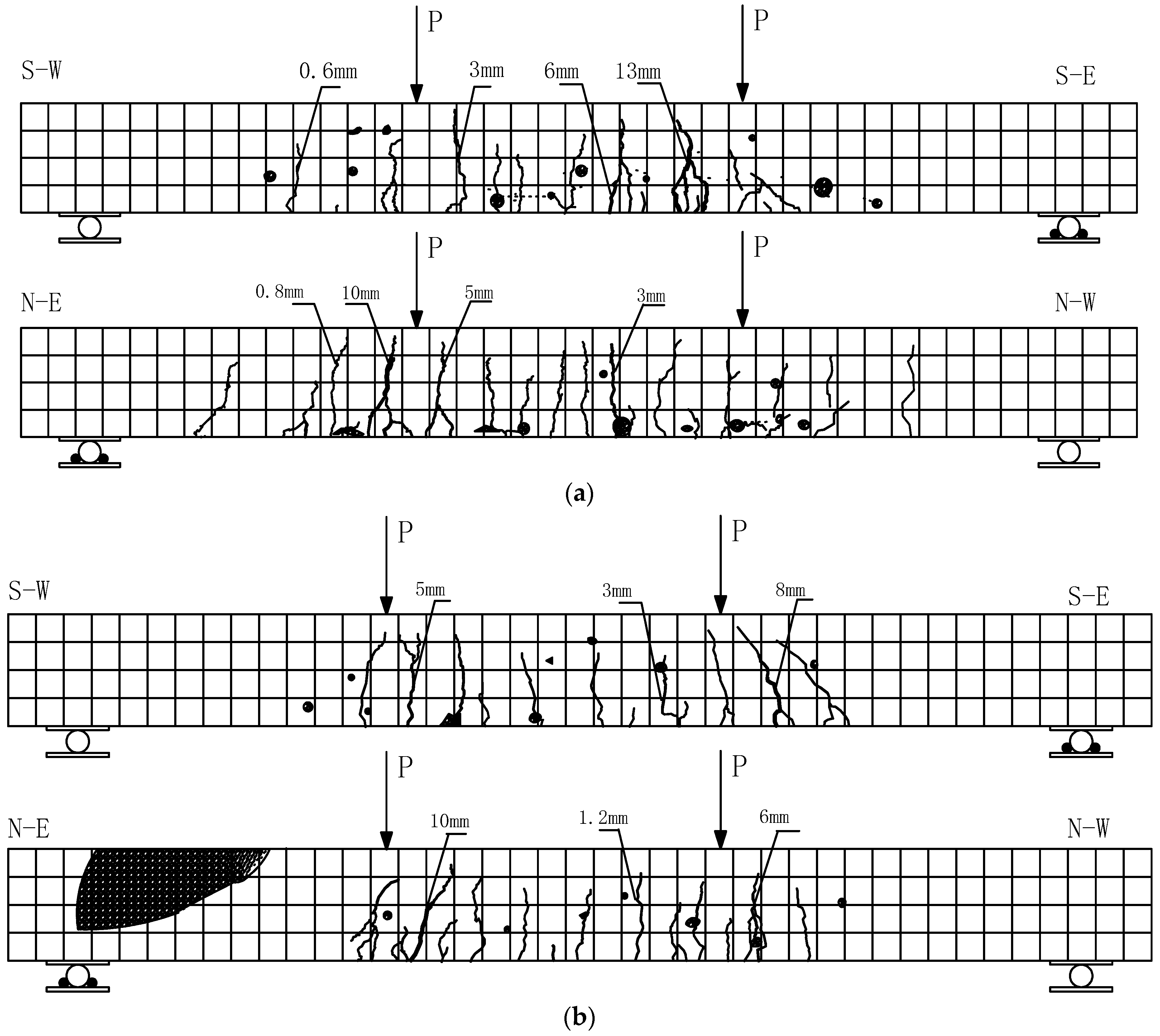
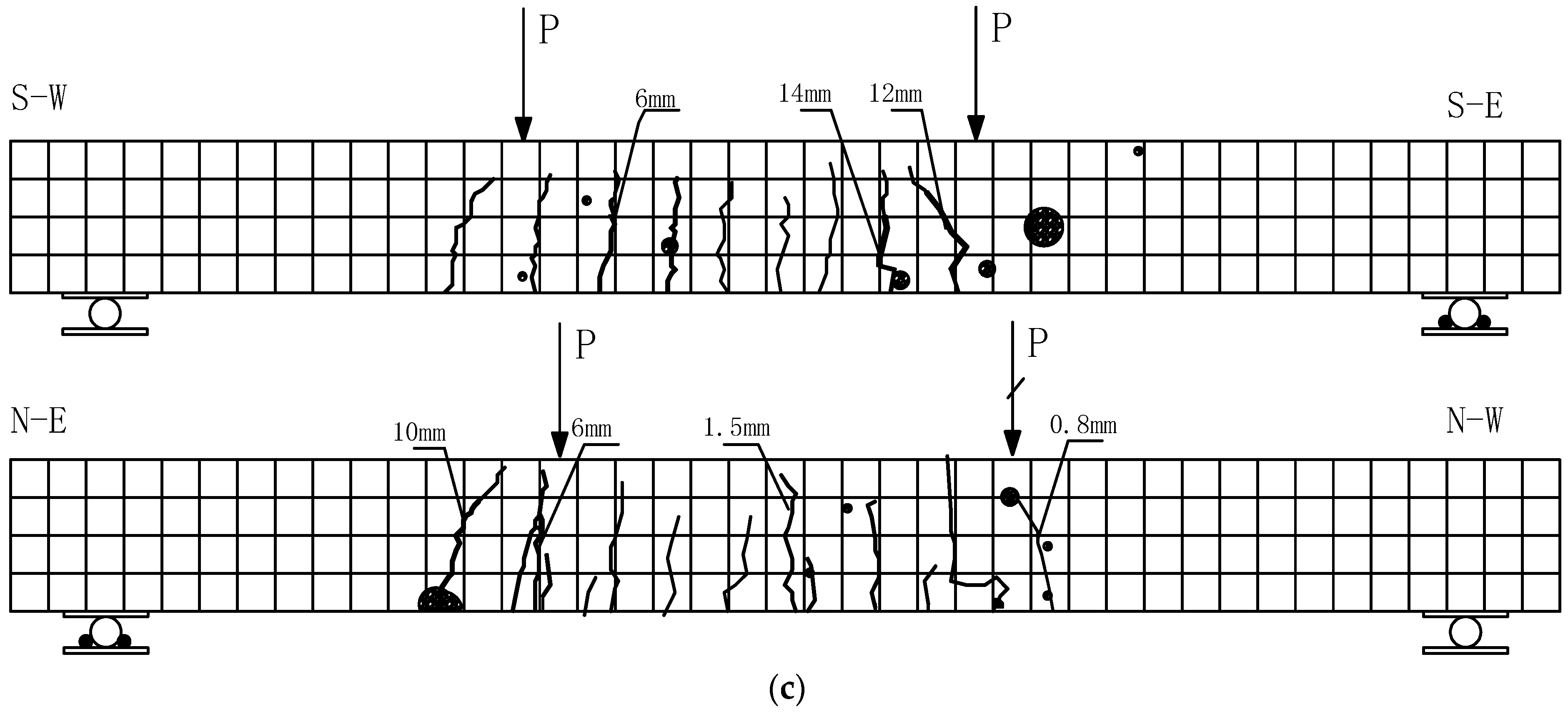


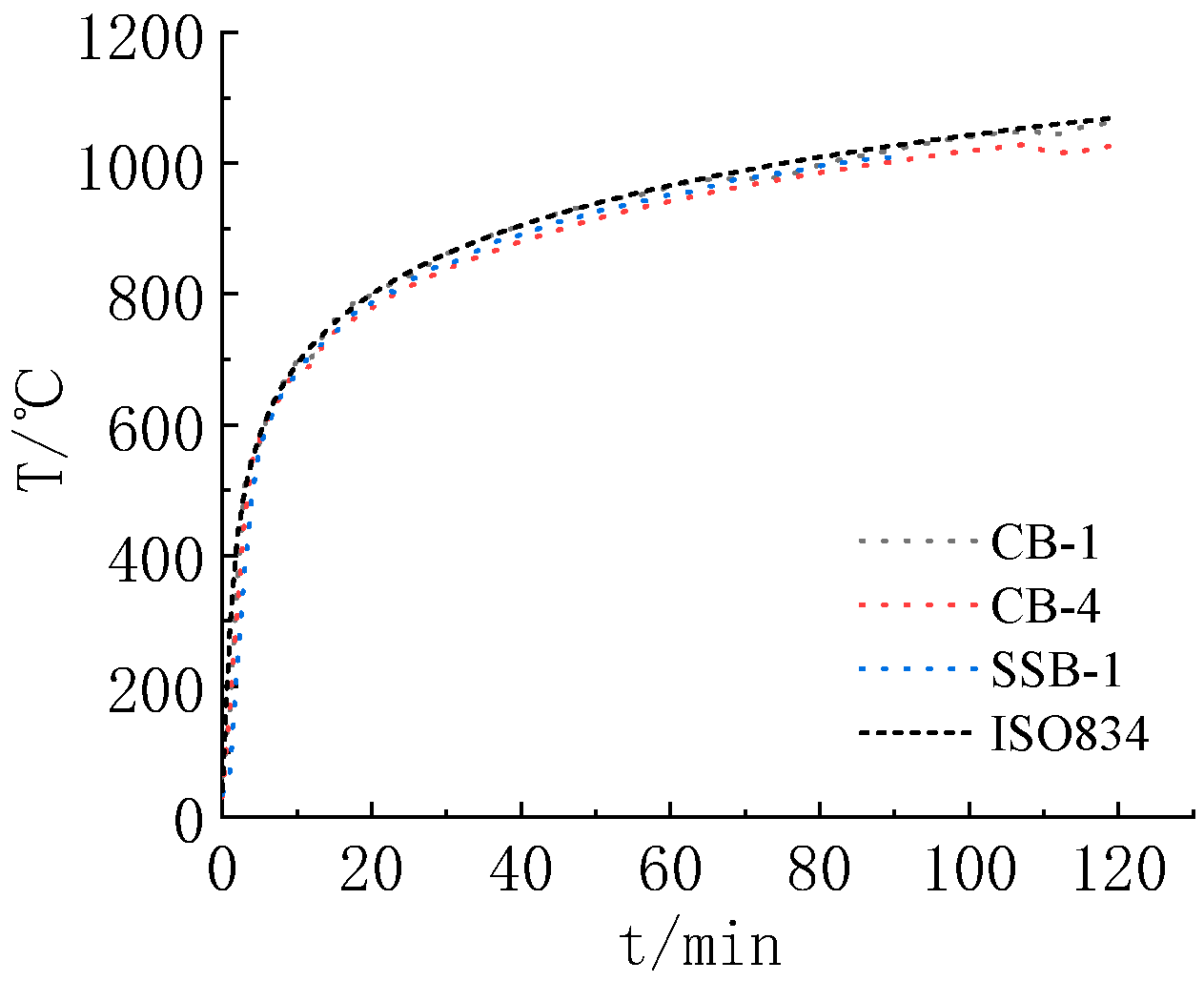
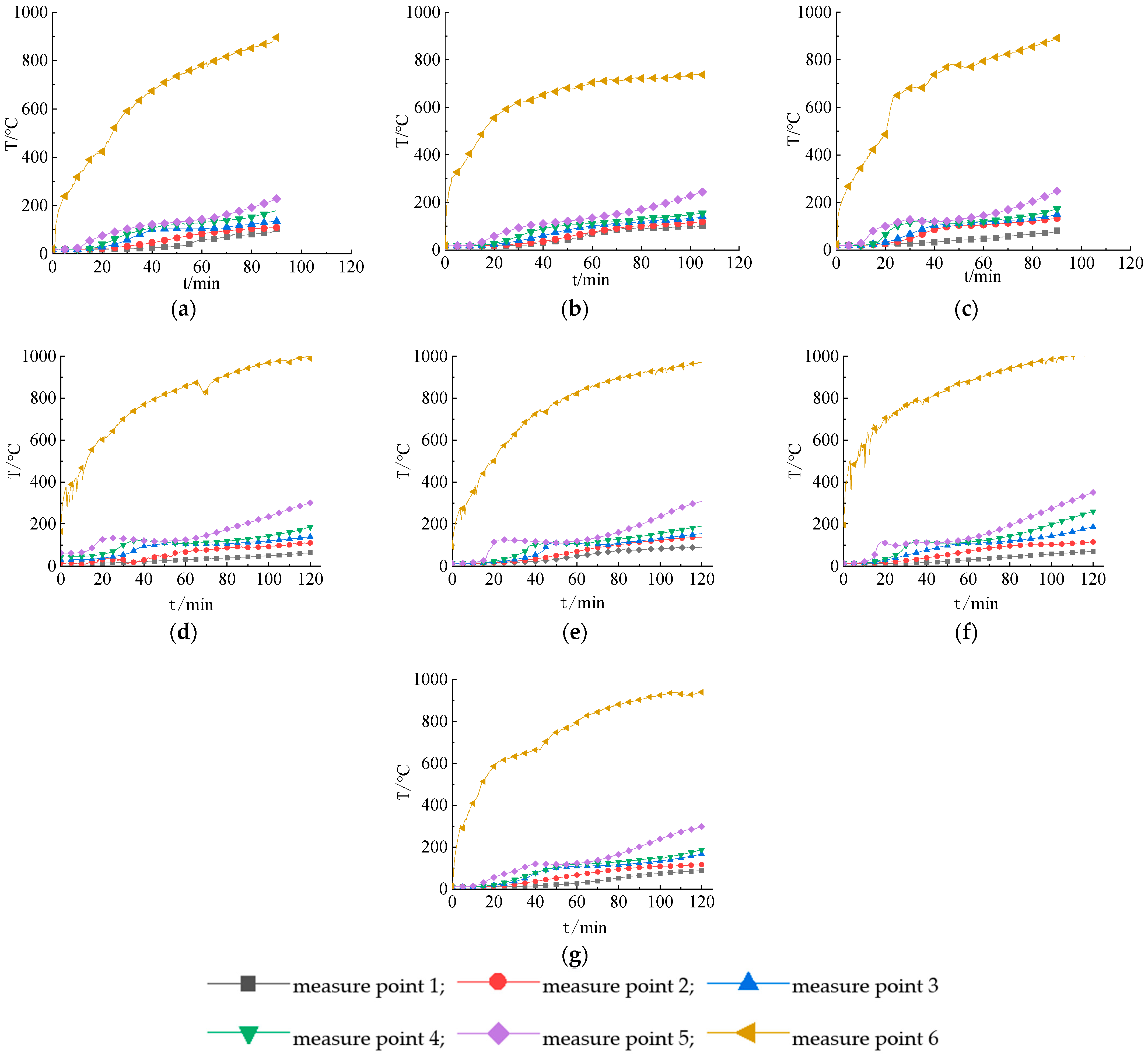

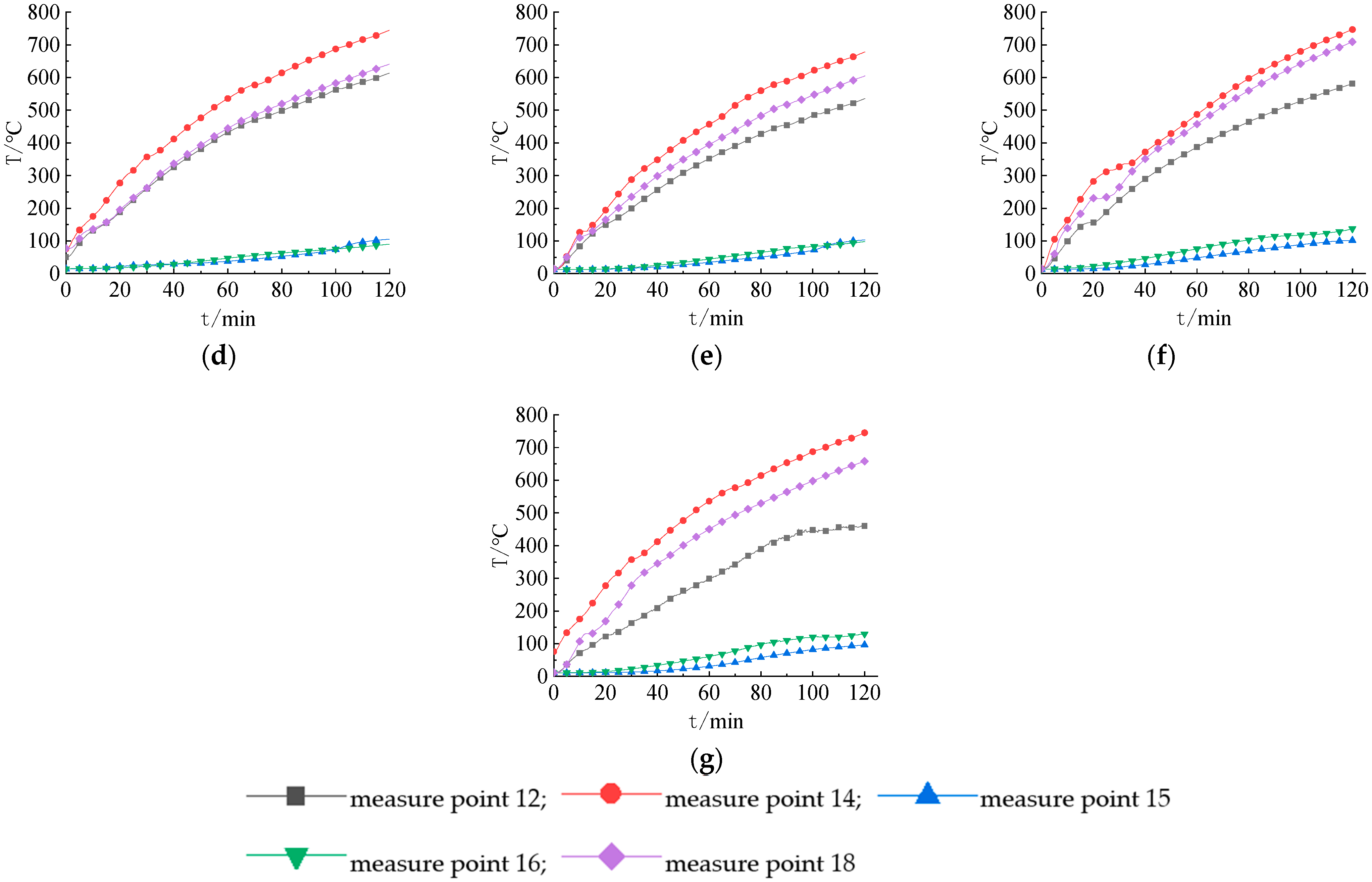
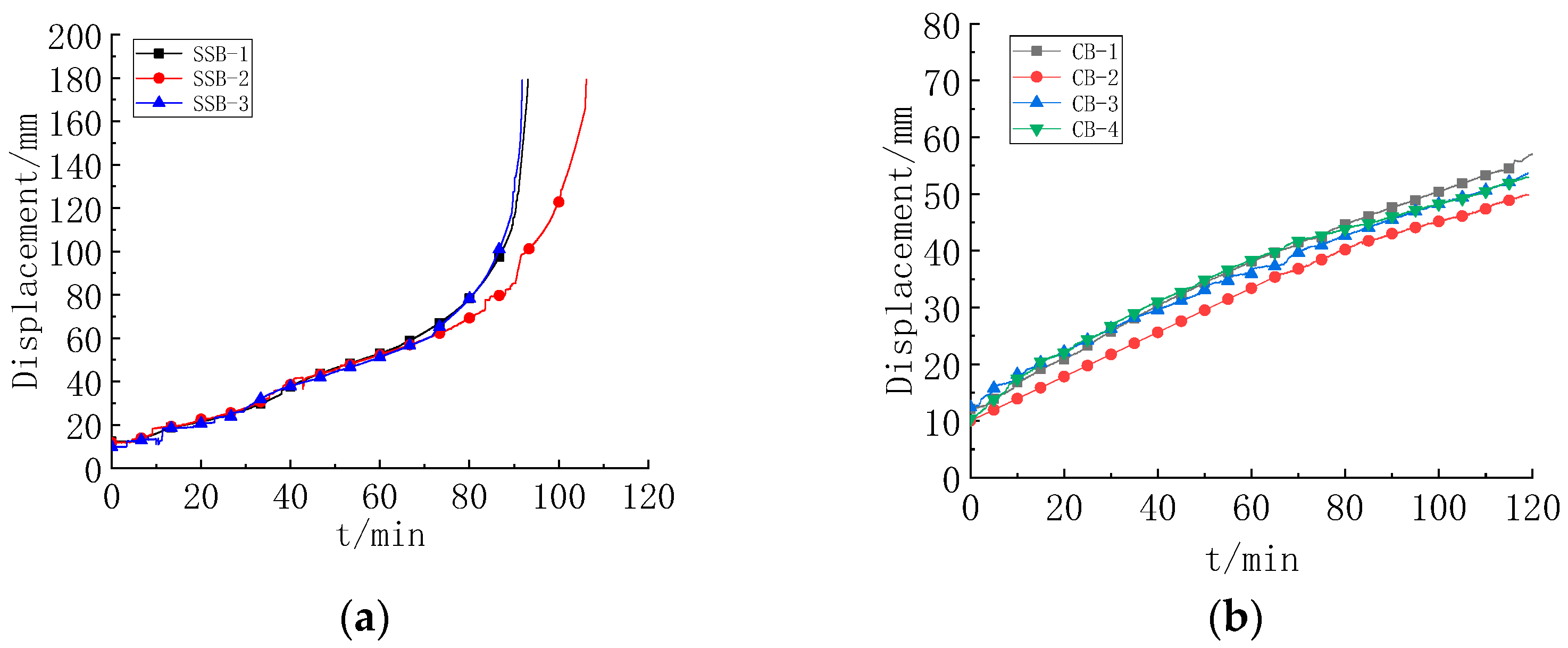
| Serial Number | Concrete Strength | Iron Tailings Sand Content/% | Fired Condition | Applied Dead Load/kN | Fire Exposure Time/min |
|---|---|---|---|---|---|
| SSB-1 | ITSCC30 | 100% | - | 108 | 93 |
| SSB-2 | ITSCC40 | 100% | - | 110 | 106 |
| SSB-3 | NSCC30 | 0 | - | 108 | 92 |
| CB-1 | ITSCC30 | 100% | Double span | 108 | 120 |
| CB-2 | ITSCC40 | 100% | Double span | 110 | 120 |
| CB-3 | NSCC30 | 0 | Double span | 108 | 120 |
| CB-4 | ITSCC30 | 100% | Single span | 108 | 120 |
| Concrete Strength | Natural Sand/ Kg/m3 | Iron Tailings Sand/ Kg/m3 | Cement/ Kg/m3 | Fly Ash/ Kg/m3 | Mineral Powder/ Kg/m3 | Crushed Stone/ Kg/m3 | Water/ Kg/m3 | Water Reducing Agent/ Kg/m3 | Water Binder Ratio |
|---|---|---|---|---|---|---|---|---|---|
| PC30 | 840.5 | 0 | 214 | 60 | 75 | 997 | 170.5 | 7.00 | 0.51 |
| ITCC30 | 0 | 701 | 271 | 76 | 95 | 1108 | 215.9 | 9.35 | 0.51 |
| ITC40 | 0 | 572 | 320 | 90 | 112 | 1026 | 203.5 | 11.00 | 0.41 |
| Serial Number | Iron Tailings Sand Content | Crack Width/mm | Fire Endurance/min |
|---|---|---|---|
| SSB-1 | 100% | 13 | 93 |
| SSB-2 | 100% | 8 | 106 |
| SSB-3 | 0 | 14 | 92 |
| Serial Number | Iron Tailings Sand Content | Maximum Deflection/mm | Maximum Crack Width/mm | Residual Bearing Capacity/kN |
|---|---|---|---|---|
| CB-1 | 100% | 60 | 16 | 268 |
| CB-2 | 100% | 52 | 8 | 278 |
| CB-3 | 0 | 56 | 15 | 265 |
| CB-4 | 100% | 55 | 9 | 260 |
Publisher’s Note: MDPI stays neutral with regard to jurisdictional claims in published maps and institutional affiliations. |
© 2022 by the authors. Licensee MDPI, Basel, Switzerland. This article is an open access article distributed under the terms and conditions of the Creative Commons Attribution (CC BY) license (https://creativecommons.org/licenses/by/4.0/).
Share and Cite
Zhou, Y.; Yang, Z.; You, Z.; Wang, X.; Chen, K.; Guo, B.; Wu, K. Experimental Study on Fire Resistance of Concrete Beams Made with Iron Tailings Sand. Buildings 2022, 12, 1816. https://doi.org/10.3390/buildings12111816
Zhou Y, Yang Z, You Z, Wang X, Chen K, Guo B, Wu K. Experimental Study on Fire Resistance of Concrete Beams Made with Iron Tailings Sand. Buildings. 2022; 12(11):1816. https://doi.org/10.3390/buildings12111816
Chicago/Turabian StyleZhou, Yunlong, Zhinian Yang, Zhiguo You, Xingguo Wang, Kaijiang Chen, Boyu Guo, and Kai Wu. 2022. "Experimental Study on Fire Resistance of Concrete Beams Made with Iron Tailings Sand" Buildings 12, no. 11: 1816. https://doi.org/10.3390/buildings12111816
APA StyleZhou, Y., Yang, Z., You, Z., Wang, X., Chen, K., Guo, B., & Wu, K. (2022). Experimental Study on Fire Resistance of Concrete Beams Made with Iron Tailings Sand. Buildings, 12(11), 1816. https://doi.org/10.3390/buildings12111816








